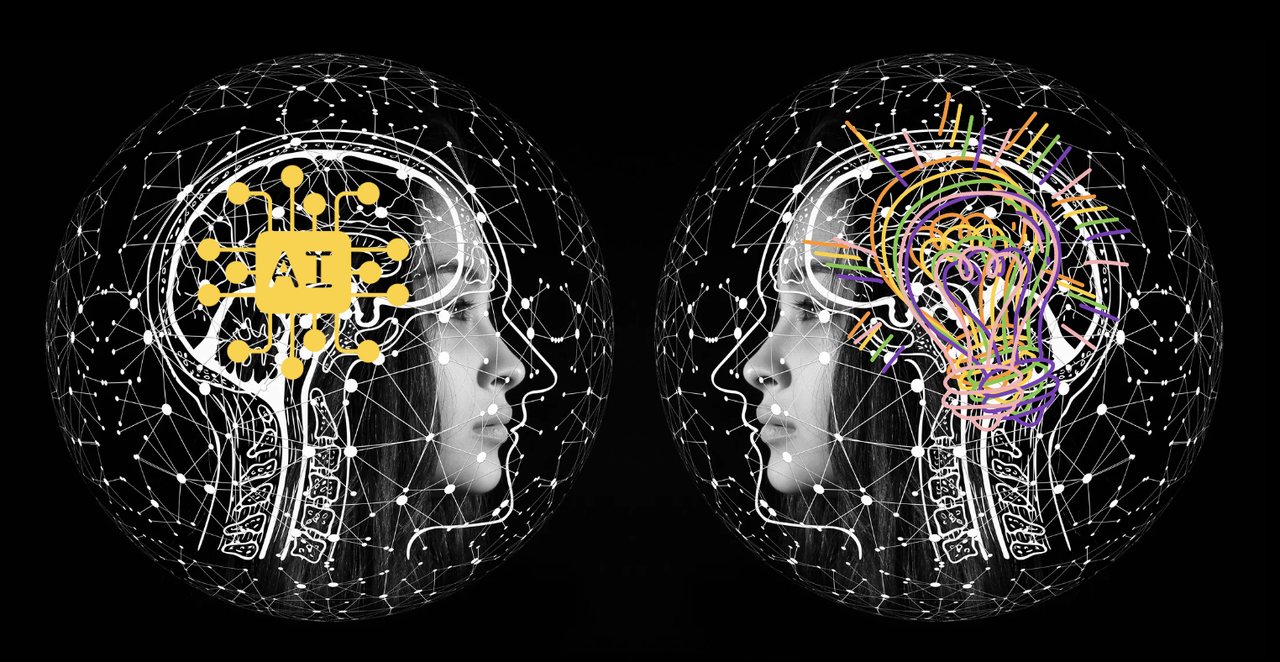Research Objectives:
This study aims to explore strategies to secure the jobs of neurodivergent employees within Contact Management (CM) industries, such as Business Process Outsourcing (BPOs) and Knowledge Process Outsourcing (KPOs).
Keywords:
Artificial Intelligence (AI), Contact Management (CM), Neurodiversity, Dry Promotion, Neurotypical (NT) Population, Job Security
Bio
Dr. Amit Phillora is driven by “Service Acumen, Operational Excellence, and Continuous Improvement.” With expertise in project management methodologies, psychometric analysis, recruitment analysis, yield ratio techniques, and escalation management, he excels in deriving optimal value. Trained in recruitment analysis and psychometric testing, Dr. Phillora specialises in emotional intelligence and has worked extensively in neurodiversity, neuromarketing, and breast cancer. His leadership, analytical, problem-solving, and communication skills, combined with the ability to network with stakeholders at all levels, have delivered extraordinary results. Recognised with multiple awards, including Pillars of India and the UN 75 Peace Award, he is also a member of InSc.
Abstract
In 2024, Artificial Intelligence (AI) has increasingly taken over a significant portion of the workforce, leading to widespread job insecurity among employees. Major multinational corporations like Amazon, Google, and Microsoft have had to downsize, resulting in the loss of numerous jobs. This situation has created a heightened sense of anxiety, particularly among neurodivergent employees, such as those with autism spectrum disorder (ASD) and Attention Deficit Hyperactivity Disorder (ADHD). This study aims to explore strategies to secure the jobs of neurodivergent employees within Contact Management (CM) industries, such as Business Process Outsourcing (BPOs) and Knowledge Process Outsourcing (KPOs). Specifically, the research will investigate whether dry promotions—promotions without a corresponding increase in pay—serve as a positive motivational factor for neurotypical employees by providing a sense of job security or if they contribute to negative motivation. To achieve this, the study will employ various psychometric tests to assess the personality traits, IQ levels, and emotional stability of neurodivergent employees. Understanding their current mental health status will be crucial in designing an AI-based recession strategy aimed at ensuring their job security in the evolving job market. This research hopes to contribute to the development of more inclusive workplace practices that support neurodivergent individuals in the face of AI-driven changes.
Introduction
To understand how to work with neurodivergent population specially with Autistic and ADHD Employees we will first have to understand D.E.I model.
Diversity is the combination of unique skills, experience, perspective, and cultural backgrounds that make us who we are and ultimately benefits our global customers. It’s full range of visible and invisible identities, including but not limited to gender, race, status, race, ethnicity, nationality, physical and cognitive ability, sexual orientation, military status, education, age/generation, social class, language etc. individuals and groups are not one dimensional, and in fact are shaped in multiple and intersecting identities.
Equity is the fairness of access, opportunity, and advancement for all. Equity looks to identify and eliminate barriers that have prevented the full participation of some groups. It is also about ensuring that policies, practices, and systems provide all individuals access to the opportunities, resources, and recognition to be successful.
Inclusion is providing an environment where our employees feel valued, trusted, connected, and informed. It’s about recognising a d valuing the different lived experiences of our teams and leveraging their unique competencies and perspectives, so that everyone may experience ownership and empowerment.
Understanding basics of Neurodiversity
Neurodiversity is an idea that people experience and interact with world in different ways, and that differences are not viewed as defects. Neurodiversity is a term representing individuals who cognitively process differently than what society considers normal.
As per World Health Organisation (WHO):
- 15 % of humanity is livIntroduction ing in disability.
- Less than 12% of this group are included in diversity programs.
When we discuss or talk about an individual then it referred as Neuro-Divergent (ND) or Neuro-Typical (NT) or Atypical.
Let’s try to understand following different types of ND/NT who add to Neurodivergent populations:
- Autism
- Attention Deficit Hyperactivity Disorder (ADHD)
- Dyslexia
- Dysgraphia
- Other Learning Disorders
History about Hiring NT Workforce
Hiring Autistic candidates’ movement was started in March 2013, when SAP, one of the global enterprise software and technical company announced its intention to have 1% of its workforce to be composed of Autistic Employees by end of year 2020. That was one of the reasons why hiring of autistic candidates got increased in the US. Even though the hiring of autistic candidates got increased, however, 85% of autistic populations still remained unemployed.
In 2019, a group of employers with established autism hiring programs published the Autism@WorkPlaybook, in which they noted the most critical factor for the success of an Autism@Work program was the ability to source talent.
It was observed and learnt that the traditional processes for recruiting autistic talent was not good and in addition to that the US Vocational Rehabilitation System (VRS) was not an open platform. The state VRS restricted employers from accessing the database and find NT candidates for hiring. This also restricted them to find and identify the type of disability the person might be having. It was further found that not every autistic or NT person was registered under VRS. Further being registered with State VR system, didn’t give assurance that neurodivergent/disabled graduates would be to find enough opportunities for filing vacant positions. Therefore, the agencies looking for Neurodivergent or autistic talents must be equipped with strong resources for finding out and identifying NT candidates.
In 2017, Marcia Scheiner. President and founder of Integrate Autism Employment Advisors developed guidelines called” An Employers Guide to Manage professionals on Autism Spectrum”, to address employers needs in supporting the existing autistic employees. This was the time when Autism@work programme was just launched, usually with small pilot groups and employers needed guidance on creating a supportive and inclusive workplace for their autistic colleagues.
In 1998, journalist and autism activist Harvey Blume introduced this concept in broader way when he wrote in The Atlantic, “ND may be every bit as crucial for human race as biodiversity is for life in general. Who can say what form of wiring prove best at any given moment?”
The Myth of Normal Brain
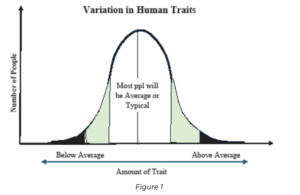
The Bell-Shaped Curve of a Normal Distribution
“Average, Standard & Normal” are part of a concept we are apply every day – from height to IQ, blood pressure & even cloth size – to make sense of the world around us.
When we try to describe human traits, the normal distribution predicts that about two thirds (68%) of the people in a sample will fall within the “average”, range, with fewer people represented at the extremes.
Example
Random Sample Size = 1000 Average Score = 100 Expectancy for 680 People to have IQ Between = 85 – 115.
Fewer & fewer people will be represented as their IQ scores get further away from 100 in either direction.
Another example is of a women shoe store. If average shoe size is 7 then the shop would more like to keep more styles for shoe sizes ranging from size 5 to 9 and not of size 11 or above as rare large feet people would they get for selling and would know if larger feet come to their shop. In similar way its next to impossible to plot the complexity and variety of human cognitive & processing styles, yet in many ways society assumes that there is a standard or “typical” way of thinking & tends to accommodate the people who fall into that camp. Whereas there is no way of “normal” thinking, most of the people assume that others process information the same way they ever think of it at all. Due to this these brains work differently and can have significant barriers as well.
Neurodiversity
Judy Singer, Australian Sociologist & autism rights coined the word neurodiversity, which was a combination of neurological & diversity terms. It helped in articulating the needs of the autistic people and also helping them not to get labelled under disability but has now been seen as people who had different neurology
(Neurodiversity is a framework for understanding human brain function that recognizes the diversity of human cognition as a biological fact. The neurodiversity paradigm argues that diversity in human cognition is normal and that some conditions classified as mental disorders are differences and disabilities that are not necessarily pathological.)
The language of Neurominorities
In the context of work environment, there are few basic rules that can be applied to ensure the correct usage of the neurodivergent terminologies to communicate with Neurominorities or ND or NT workforce.
- ND, on standalone basis, is an idea that there is a biological difference in all human minds. It’s not the characteristics of one individual.
- Neurodivergent refers to neurological variations of a group, however some researchers advocate and uses the term for Neurodivergent individuals.
- Autistic and Neurodiverse or Neurodivergent are not interchangeable terms.:
- An autistic individual is neurodivergent, but a Neurodivergent individual may or may not have autism.
- The term Neurotypical (NT) refers to someone who is not neurodivergent. However, a person who is not autistic is not necessarily neurotypical as they may be neurodivergent in another way.
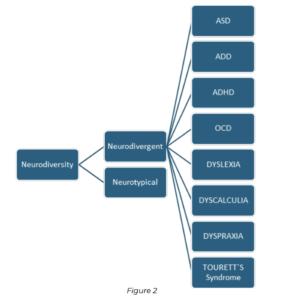
Why Should we hire Autistic Talent?
A Recruiter, hiring manager or Diversity and Inclusion professional is said to be successful when he or she can hire and retain talents in their companies. In the US, at the beginning of year 2020 the labour force recorded was 164 million, it was assumed that to fill any vacancy by hiring talent is an easy fix. Soon when covid 19, pandemic hit all of us, the unemployment rate in the US itself got jumped to 3.5%. Still employers adjusted and resumed hiring and finding right talent for their works, hiring became tougher and difficult in comparison to the past. However, a large number of talents got noticed in autistic community.
2Let’s understand that statistical data: Secondary Data
The Neurodivergent Job Candidate, Recruiting Autistic Professional by Marcia Schener and Joan Bogden, Chapter 2
In the US, one in every 54, 8 years old is diagnosed with autism spectrum disorder (ASD): That is 1.85 % of Children population have ASD condition, whereas 5.4 million adults are estimated to be autistic. The employment condition of approximately 2.2% of Autistic population is not that good in comparison to other disable populations. By the time they hit their 20s, only 58% of these autistic population will have some form of earning income in comparison to other intellectual disable (74%), & 94% for those having learning disabilities. 35% of Autistic students who attended college are in bad economic status in comparison to their peer autistic people who never attended college. That’s how 85% of autistic population land into unemployment and under empowerment situations. Which makes a good number of autistic population available for employment.
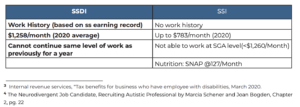
What benefits do recruiters get by hiring a neurodivergent?
Business Benefits
Better Talent: A NT think different and have very creative way of problem solving.
Increased productivity
Lower Turnover
Employee Engagement
Brand Recognition
3Tax Credits: Government programs targeted at encouraging employers to hire people with disabilities provide tax credits to small and large businesses at the federal and state levels. there is a concept of Disability Access Credit (DAC): which means that enterprises at federal levels who have earnings of $ 1 million or have ≥30 employees might be eligible for DAC. The amount can range between $ 250 to $ 10,000. All employers are eligible for Workforce Opportunity Tax Credit, which ranges from $1,100 to $ 9,600 per employee, which again depends on hiring of employee and length of employment.
Economic4 Benefits Social Security Disability Income (SSDI) Vs Supplemental Security Income (SSI) Federal Financial Support Programs for individuals with disabilities For Every 1% of Autistic adult employed $222,000 (SSI, SNAP, and Medicaid) x (1% autistic adults)54,000 = $1.2B SNAP = Supplemental Nutrition Assistance Program
Societal Benefits: J.K.Y Lai, E Rhee and Nicholas found that employment plays an important role in Mental health of people. It helps in issues related to suicide, depression and Anxiety happening due to unemployment. Studies shows Let’s try to understand how an Autistic Jobseeker is different from us Normal.
May also be eligible for SSI Medicaid: $3,000(Adult) to $20,000+(disabled)
Most hiring managers look for following qualities for their candidates:
• Strong Communication Skills,
• A “can-do” or Positive Attitude,
• Self – Awareness,
• Teamwork focus.
When interviewing the Autistic or NT candidate, it’s important to create inclusive and supportive environment. There are guidelines which needs to be considered while interviewing NT candidate, that unemployed people get 30% more negative emotional experience in comparison to a normal employed person, Autistic people are depended on their family for financial and other needs and live with aging parents. Financial independence helps them gaining self-esteem and confidence to live independently. 5History of Disability & Neurodiversity Hiring Initiatives: Timeline of Disability hiring programs few of them are listed below:
- Disclosure of Autism or Neurodiversity: As a recruiter you must disclose to the candidate will be checked for Autism and other Learning Disabilities tests, during the job interview. It’s your personal decision based on your needs and comfort level. Please note that, Under the Americans with Disabilities Act (ADA), you only need to disclose a disability when requesting accommodations for the application or interview process.
- Highlight Unique Skills: If it’s decided to disclose the Autism diagnosis, identify the unique skills that the person is bringing in with themselves. For example, mention, the ability to problem solving techniques blended with creative mind.
- Practice interview Questions: Prepare for common interview questions. Some examples include:
o Tell me about yourself.
o What are your strengths and weaknesses?
o Describe a problem you’ve solved in the past. o What is your dream job?
o How do you work in a team? o What type of work environment do you thrive in?
Communication Guidelines:
- Always be direct and upfront
- Be calm and patient and give adequate time for responding back to your question, don’t rush for answers.
- Encourage comfort and openness and support flexibility.
- Be open for alternative interview modes or venue
- Be observative and understand their body language and nonverbal cue.
- If something is not clear or in doubt, stop and ask for clarification o Provide writing surface if required.
Seek Advice: Talk to professionals who know the individual well to determine the best interview approach. Consider interviewing in a familiar place with a familiar person present.
To understand more about hiring Autistic Candidates, Wales Autism Research Centre have designed Guidelines for hiring Autistic Individuals by Ben Winn.
Let’s try to understand differences in Neurotypical Thinking Understand that disability and Disorder are not the same thing there is a difference between the two. Based on, “medical model” autism spectrum disorder (ASD) is considered as Neurodevelopmental disorder. Clinical Psychologist or Psychiatrist use Diagnostic & Statistical Manual of Mental Disorders (DSM) as a reference to study mental disorders and classify them. We should be able to distinguish between development disorders like autism and psychiatric disorders. As a recruiter or hiring manager you must know that ASD is not a Mental illness, and it falls under the category of development disorder.
There is a difference between developmental disorder and psychiatric disorder. Developmental disorders are lifelong and cognitive based conditions that affects persons social interactions, and their challenges may vary as per the different life stages of their lives.
Whereas Psychiatric disorders are more of emotional based and not cognitive based conditions.
Disability is a legal term that the Americans with Disability Act 1990 (ADA) use to determine eligibility for accommodations at workplace. As per ADA, disability can be metal or physical which creates hinderance performing daily tasks, social engagement. Invisible disability like Autism, bipolar disorder, multiple sclerosis, diabetes, epiclesis etc are not obvious, so at the time of hiring employer may ask for medical documentations, so that disable employee can special accommodations at workplace.
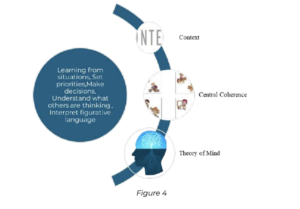
Executive Functioning Skills (EFS) are set of cognitive skills that help us in getting our things done and regulates our behaviour. It also helps us in accomplishing our goals.
Executive Functioning Skills (EFS) are set of cognitive skills that help us in getting our things done and regulates our behaviour. It also helps us in accomplishing our goals.
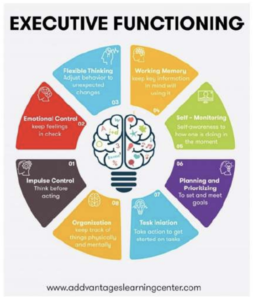
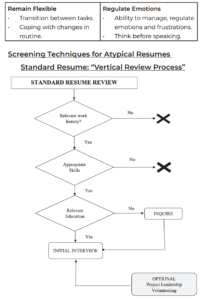

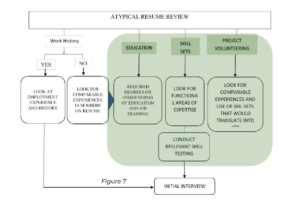
A survey of 2,000 hiring managers conducted in 2018 confirms the impact of 1st impressions Following behavior was observed in interviewers:
- 33% knew if they would hire a candidate or reject within 90 seconds of meeting them.
- 65% did not hire a candidate who had poor eye contact with them,
- 50% won’t consider the candidate’s dress sense, their body language or their odor or the way they opened or closed doors or the way they walked in.
- 40% felt that if a person is not wearing a smile on their face, then it’s a good reason to not hire that applicant.
- 40% would reject an applicant based on the quality of their voice and overall confidence. Like any candidate an NT must undergo Interview funnel and candidates need to pass through each level to avoid rejection and get recruited.
INTERVIEW FUNNEL FOR JOB APPLICANTS
After a rigorous hiring process, when the hiring manager shortlists the selected candidates then they pitch an offer to the selected candidates, now it’s up to them to accept the offer or leave the job opportunity offered to them. For that it’s important to understand what Offer Acceptance Rate (OAR) is.
OAR = (Number of offers Accepted /Number of offers) X100
There are many reasons due to which a shortlisted candidate can turn down a job offer. according to a job seeking site called glassdoor.com, top3 reason for declining a job opportunity are:
- Better salary, perks & benefits.
- Poor recruiting/interviewing experience, experienced by job applicant.
- Poor or Negative image of employer.
Passing all gates when a Candidate enters inside an Organisation, then it becomes important for the Organisation to improve the retention ratios as recruitment and selection with training is a very expensive and tiring process.
Employee Retention Rate = [(Total # of Employees – # of Employees who left)/Total of # Employees)]
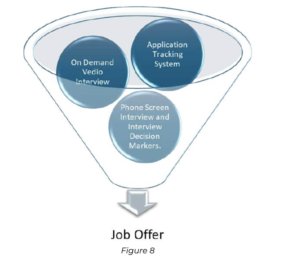
- As per World Institutes ’2020 report, in 2019 major reason for increased attrition rates in companies were:
- 20% People left because there was no Career Growth and poor Career Development in their existence companies.
- Over Workload and poor increments resulted in poor work life balance, due to which 12% of the workforce left their existing companies and switched to different companies which provided better working environment and opportunities to balance personal and professional lives of employees.
- Toxic work culture and bad managers created a situation which let to loss of another 12% of workforce.
- The major reasons for Neurodivergent to leave was:
- Bullying
- Sensory Overload
- Social Misunderstandings
- The percentage of such is 78%, the report was made by work institutes.
Retention Rate can be improved, and Attrition rates can be brought down in NT working talent. All we must do is taking care of following points:
- Maintain Supportive working environment.
- Education & Training on sensitive topics like POSH, D.E.I, & Neurodiversity.
- Generating Awareness about NT Workforce
- Train and Make Neuro-Recruiters who specialise in hiring NT Workforce & candidates who specialise in Neuro Marketing.
- Management Training
- Manager Support System.
Artificial Intelligence (AI), Dry Promotion and NT Workforce Job Security
As per recent reports shared by CNN in one of their articles stated that AI is closely linked to major layoffs in IT sectors because the companies are investing a huge amount in Machine learning, automation and AI based technology. Tech Giants like Google, Microsoft, IBM had to let their people go as they have invested a good amount of time and many in developing and using AI based applications like Chat GPTs. Due to this drift the job security is reduced even for top IT or Tech experts. Now, when companies are struggling hard in balancing human workforce and AI based applications. It’s time to upscale the existing talent so that they are able survive in this AI based world. As per layoffs, about 212,294 were laid off from IT sector in year 2023 which was far more than the numbers of people got laid off in 2022 numbering 164,709. Microsoft after firing 10,000 employees and announced that they will be investing on AI based applications, Chat GPT etc. Nov 2023, Facebook laid off their 10,000 employees after cutting 11,000 positions. A software engineer who is trained in AI and ML gets 12% higher salary in comparisons to a normal software engineer.
https://edition.cnn.com/2023/07/04/ tech/ai-tech-layoffs/index.html
Now when we see retaining a normal workforce is getting difficult then how we will be able to retain NT workforce who have cognitive and psychological disorders.
Dry Promotions
As we know NT specifically Autistics people are creative minds, socially remains disconnected and focus on primary goals, due to sensory overloading and selective mutism. They can do one task at time. We know that companies are investing a lot in AI and ML due to with salary hikes are almost negligible, so what we can do is, instead of finding a new NT talent who is equipped with AI skills, why not promote the existing NT Individual by upskilling them in AI, ML and Automation skills. By using Dry Promotion, we can give them Power and Authorities with Job security with same increment or lesser increment in comparison to the increments which use to happen in past.
This will act as positive motivating factor as promotion in hierarchy will boost their moral and having equip to work with AI and ML will be another positive factor.
This will help:
- Retention Rate in NT population
- Opportunity for Trainers to train Neurotypicals
- Cost saving in hiring and training new NT talents
- Existing NT talents of the company will be able to learn in faster way and productivity rates will be get improved because they know how their companies work.
We have targeted Contact Management Industries which are composed of BPOs and KPOs. Contact management companies are companies which work on Contacts. Contacts that are generated by Customer, Clients, their employees. They could be through Emails, Phones and Chats.
E-commerce giants like Myntra, Amazon etc uses Chat bots and Auto bots in dealing with customers. Our aim is to retain NT techies who can design, modify and update the AI tools and make them more user friendly. Most of the NT techies are depended on AI for their day to day lives, like Active Noice Cancellation (ANC) headphones, Chat bots, Virtual mode of communication in comparison to physical mode. So, the understand the user interface better and their ideas and design proposals will help in AI applications development keeping Normal and NT populations in mind.
Literature Review
The study is very much inspired from the book “The Neurodivergent Job Candidate, Recruiting Autistic professional by Marcia Scheiner & Joan Bogden”. The explains about neurodiversity and autism. The author had explained about the challenges which were faced by hiring managers in hiring neurodivergent candidates and explain how to create a working model for working with neurotypical working professionals. The book helps in identifying differences between traditional resume review and atypical resume reviews.
A health writer Ariane Resnick had written an article with title “What Does It Mean to Be Neurodivergent?” for Websites well mind, where she had explained about neurodiversity. The Article has a live poll on Question: Do you identify as neurodivergent? The result of this poll on June 2,2024 at 13:36 IST is:
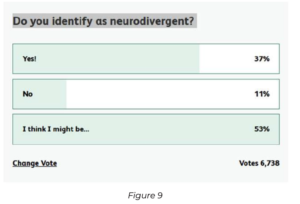
In The Neurodiversity Edge, renowned Oxford-trained cognitive scientist, neurodiversity expert, and business leader, Dr. Maureen Dunne presents a pioneering framework to harnessing the power of neurodiversity to navigate the most important human resources revolution in the modern era.
Cherry Gupta, wrote an article with title: “Dry promotion’: All about the appraisal trend offering higher designation without pay hike”, which got published in Online Newspaper:” The Indian Express”
Roberta Matuson had written an article on Here’s What You Should Do If You Receive A ‘Dry Promotion’. Here she tried to explain what reason is behind getting dry promotion. She touched on topics like are there is any benefit in accepting a dry promotion and does no money really means no money. The article came in online site of Forbes
To understand the terminology related psychology and mental health like disorders, disabilities, help was taken from Penguin dictionary of Psychology by Arthur S. Reber, Second Edition.
K Ashwathapa had explained concepts related to Managing benefits and Wellbeing, A Safe and Healthy Environment, Labour Laws were very well explained in his book, Human Resource Management.
Mike Byon wrote a book: Ultimate Psychometric Tests, in which there were more than 1000 Verbal, Numerical, Diagrammatic and Personality tests.
Udai Pareek in his book Organisation Behaviour and Process, had explained different concepts related to the Perceptual process, Interpersonal styles, Personal effectiveness,
What Does It Mean to Be Neurodivergent? (verywellmind.com)
https://indianexpress.com/ article/lifestyle/workplace/ got-promoted-but-no-payraise-dry-promotions-appraisal-trend-9285951/
https://www.forbes.com/sites/ robertamatuson/2024/05/01/ what-is-dry-promotion/?sh=57b565b42a52
Leadership styles, work motivations, managing frustration, managing stress and burnouts etc.
Research Methodology
Sampling Methodology: Quota Sampling Target population: MNCs like Amazon.com, Accenture, Universities like APS, IGNOU. Industry type: Contact Management Age Group: 18 – 45 years
Parameters
ASQ: Anything Above 26 is Autism ADHD: Anything above and equal to 55 is ADHD Sample Population: Autistic, ADHD. Country: India.
Psychometric Tests:
Emotional Intelligence Scale (EIS), Personal Style Inventory/Indicator (PSI). Neuro Divergent Tests: Autism Test for Adults, ADHD Test for Adults Sample Size: 13 NTs (Either Autistic or ADHD or Both)
Hypothesis Testing
Generally, organisations want to retain the employees to avoid unnecessary expenditure towards hiring and training new candidates. Amongst various performance parameters of an employees the most important parameters to the organisations are Overall Performance (Productivity) and Quality of work. For this hypothesis testing main logic used was to study actual scores awarded by the organisation on these two performance parameters for known NT population /Sample, work out the Average Score X Bar on both parameters and apply T Test on both the samples. Here we have assumed that Population Mean =100% Hence if X Bar is =100% we will assume that Organisation can accept the retention of NT employees else not.
HYPOTHESES
First Set of Hypotheses. Productivity H0: Autistic and ADHD type of Neurodivergent individuals can be retained and be trained on new AI tools in an Organisation if Productivity X Bar=100%.)
H1 : Autistic and ADHD type of Neurodivergent individual cannot be retained in Organisation on new AI based working environment if Productivity X Bar≠100%.) Quality of Work
Neurodivergent Test | Free Am I Neurodivergent Quiz (exceptionalindividuals.com)
H0 : Autistic and ADHD type of Neurodivergent individuals can be retained and be trained on new AI tools in an Organisation if Quality X Bar=100%.)
›H1 : Autistic and ADHD type of Neurodivergent individual cannot be retained in Organisation on new AI based working environment if Quality X Bar≠100%.)
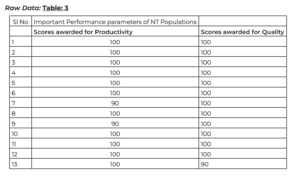
Sample Size of NT Population =13
Statistical Tool =Left tail T Test (T test was selected as the sample size was small) was used to calculate Critical Value. The average of marks (score) awarded to 13 individuals of the samples, by the organisations in Productivity and Quality of Work was checked against the critical vale of each parameter worked out based on One Tail T Test
Decision Rule: If average scores awarded by organisations on Productivity and Quality of work are more than Critical Value, statistically worked out by a T Test (T test was selected as the sample size was small) would mean that the organisation should not hesitate them to continue in the organisation. Proceedings of Hypotheses testing for Productivity and Quality of work
Table: 4
Steps Step 1 Productivity Quality Ho: Mean = 100 100 H1 : Mean≠ 100 100
Step 2
Data Sample size n 13 13 Population Mean 100 100 Estimator (x bar) 98.46 9.23 Sample SD 3.76 2.77 Population Infinite Infinite Confidence Level (CL) 0.95 0.95 Level of Significance (LOS) 0.05 0.05
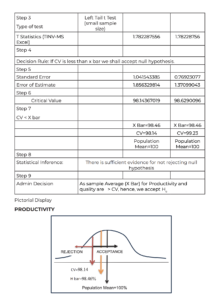
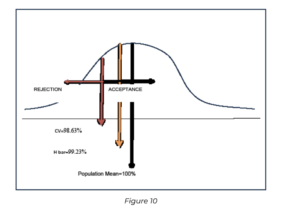
Productivity: The Table 3 shows that 11 out of 13 NT employees have scored Cent percent, 100% in the assessment of their Productivity.
Quality of Work: The Table 3 shows that 12 out of 13 NT employees have scored Cent percent, 100% in their assessment of Quality of work.
Decision: Overall performance of these NT sample employees is X bar 98.46% More than CV of 98.14% in Productivity (98.46% > 98.14%) X bar 99.23% is More than CV of 98.63% in Quality of Work (99.23%>98.63%),
Hence, we can accept H0, that is, i.e. the organisation should not hesitate them to continue them in the organisation. Or They can be retained by the organisation, as they are meeting the performance standard set by them.
Second Set of Hypothesis
Dry Promotion.
The study also considered Dry promotion as the H0: Dry Promotion with adequate training is a very good option for improving retention rates. H2 : Dry Promotion is not a good option for improving retention rates for NT Population.
Dry Promotion
As discussed earlier in this paper it was opined or hypothesised that under the threat of AI conquering the contact management industries, that Dry Promotion and upskilling them in AI, ML and Automation skills, may give them sense of Power and Authorities with Job security. It was also felt that may act as positive motivating factor and at the same time benefit organisation for not incurring additional expenditure on ne hiring.
This hypothesis was primarily formulated to find the mind set of existing NT employees whether they are in favour or against on dry promotion concept.
Data Sample Size of NT Population =13 Statistical Tool = Counting Numbers of Employees in favour of Dry promotion and Numbers of Employees not in favour of Dry promotion. Decision Rule = If percentage of Employees in favour of Dry promotion (Y) is more than percentage of employees not in favour (N) then accept Ho.
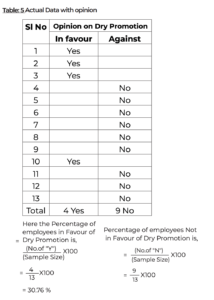
Decision. As Percentage of employees Not in Favour of Dry Promotion (No) is more than Percentage of employees in Favour of Dry Promotion (Yes), We can does not accept H0,
Inference: The NT employees are not in favour of Dry Promotion as this will not give any financial benefits to them. The sample data shows that monetary benefits are more important than continuing in same organisations on dry promotions only. They rather prefer shifting to other organisations and face further struggle to improve financial status.
Further studies done
Apart from administrating ASQ and ADHD testing on NT sample employees, additional psychometric test on this sampled employee were also administered to study the associated traits from behavioural science or psychological aspect to help the researcher: –
(a) to find out strengths and weaknesses of the sample with an aim to build up favourable strategies and recommendation on NT population for the organisation to strengthen their HR to have win- win situation for not only retaining the NT Talent and suitably promoting them but at the same time for overall sustenance, development, and growth of the organisation.
(b) To generate some likely relationship between these/or some of these traits to have some idea of the NT Employee or normal employees in the presence of nondisclosure act for purely his understanding to help the individuals/ provide some more attentions. These Tests are discussed as follows:
EIS/ EQ: There are 10 Parameters on which the test is performed to find out EQ. The study of scores in each can also help us to find their strengths and weaknesses. They can be used for designing and developing training programme. Or putting them in suitable positions, where they can really excel and bring laurels to the organisation PSI. This test gives the Personality type. This can also help organisation to place them suitably. Apart from these out puts it may be possible to guess whether an employee may be an NT. If some correlation between these factors of EQ and PSI with NT, can be made, it will help the managers to correctly address the training and developmental needs of the employees. This may help him and guessing a person whether he may be NT or Not and take suitable corrective action to deploy him for best performance in the interest of organisation. This will help him against the act of nondisclosure also.
Challenges and Suggestions for Retention of NT Employees who are under the threat of Contact Management Industry, getting invaded by AI Technology.
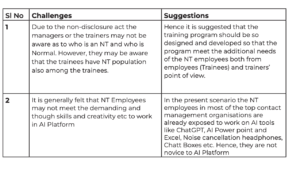

However, when organisations are shifting towards complex AI Platforms, then even existing employees may need certain special training including NTs. It is felt that the expenditure incurred on training them will be definitely costing less than hiring new NTs as Organisations still will have to employ NT on social grounds/calls.
Limitation of the study
The non-disclosure act on NT, prohibits to access data bank of NT persons, hence large data sample from NT population could not be obtained. Study with large sample size (of at least normal Distribution (Sample size at least >30) could have given better outcomes particularly in case of Dry Promotion hypothesis.
No records could be accessed where any out outstanding work of NT Employees was recorded may be due to nondisclosure act. Hence no evidence could be generated to support the retention case for NT Employees.
Suggestions for further studies.
Industries specially Contact Management Organisations/ Industries may consider doing a in depths in house study on such matters for NT employees within the bounds of non-disclosure act as they have all the required information and wherewithal to generate better future for their talented NT employees and implement the finding after thorough study in the favour of NT Population.

